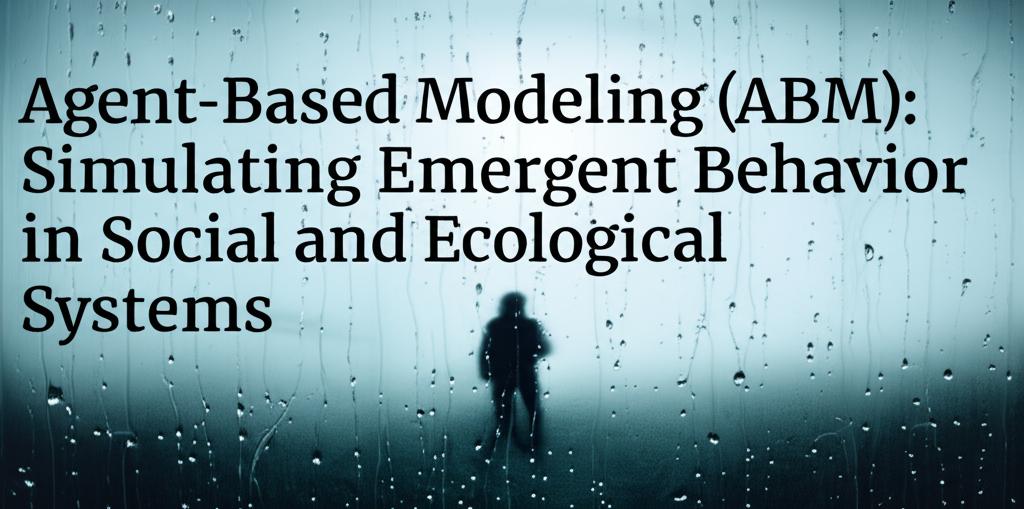Agent-Based Modeling (ABM) provides a powerful lens for understanding how complex patterns arise from the interactions of individual components within a system. Unlike traditional modeling techniques that often focus on averages or aggregate behaviors, ABM adopts a "bottom-up" approach. It simulates the actions and interactions of numerous autonomous entities, known as agents, within a defined environment.
How Agent-Based Modeling WorksAt its core, an ABM consists of three main elements:
- Agents: These are the individual, autonomous units within the model. Agents can represent people, animals, organizations, cells, vehicles, or any other discrete entity. Each agent is typically defined by a set of characteristics, internal states (like opinions or resources), and behavioral rules that dictate how it perceives its environment, makes decisions, and interacts with other agents. Agents can be heterogeneous, meaning they can differ in their attributes and rules.
- Environment: This is the space or context within which agents operate and interact. The environment can be spatial (like a geographic landscape or a grid) or abstract (like a social network). It can have its own properties and can change over time, influencing agent behavior.
- Interactions and Rules: These define how agents behave and connect with each other and their environment. Rules can range from simple reaction patterns (e.g., move away from predators) to complex decision-making processes (e.g., choosing a cropping strategy based on market prices and neighbor behavior). Interactions can be direct (agent-to-agent) or indirect (mediated through the environment, like leaving a pheromone trail).
By programming these individual agents with specific rules and letting them interact over simulated time, ABM allows researchers to observe the large-scale patterns that emerge from these local interactions.
Simulating Emergent BehaviorA key strength of ABM is its ability to capture and study emergent phenomena. Emergence occurs when the interactions between individual components lead to system-wide patterns or behaviors that are not explicitly programmed into the individual agents and cannot be simply predicted by summing up individual actions. The "whole" becomes more complex than the sum of its parts due to these interactions. Traffic jams emerging from individual driving decisions, the formation of social norms, or the resilience of an ecosystem are all examples of emergent behavior well-suited for ABM analysis. ABM provides a virtual laboratory to explore how micro-level behaviors generate macro-level outcomes, often revealing counterintuitive results.
Applications in Social SystemsABM has proven invaluable for exploring the complexities of human societies:
- Opinion Dynamics & Social Influence: Simulating how individual opinions form, spread through social networks, and lead to phenomena like polarization or consensus.
- Economic Behavior: Modeling consumers, firms, and financial institutions to understand market dynamics, wealth distribution, market crashes, or the effects of economic policies. Agents can be given realistic traits like limited information or learning capabilities.
- Disease Spread: Tracking how infectious diseases propagate through populations based on individual behaviors, contact networks, and public health interventions.
- Urban Growth and Planning: Simulating how residential choices, migration patterns, and infrastructure development shape cities.
- Team and Organizational Dynamics: Assessing how individual characteristics and interactions influence overall team performance or organizational adaptation.
In ecology, ABM (often called Individual-Based Modeling or IBM) helps unravel the intricate dynamics of natural systems:
- Population Dynamics: Modeling how individual animals forage, breed, migrate, and interact (e.g., predator-prey relationships) to understand population fluctuations and stability.
- Ecosystem Management: Simulating how ecosystems respond to climate change, habitat loss, pollution, or conservation efforts by modeling the behavior of individual species and their environmental interactions.
- Species Interactions: Exploring competition, mutualism, and other relationships between species by simulating their individual behaviors and resource use.
- Resource Management: Modeling how individual actors (like farmers or fishers) make decisions regarding resource use and how these collective decisions impact the environment (e.g., deforestation, fisheries collapse).
- Habitat Connectivity & Dispersal: Simulating how organisms like larvae or seeds disperse across landscapes, identifying critical corridors for conservation.
- Captures emergence and complexity naturally.
- Provides an intuitive way to model systems composed of discrete, interacting entities.
- Allows for heterogeneity among agents.
- Enables the simulation of adaptation and learning within agents.
- Facilitates exploring "what-if" scenarios and experiments that are unethical or impossible in the real world.
- Computational Cost: Simulating large numbers of agents with complex rules can be computationally intensive.
- Data Requirements: Defining agent behaviors and calibrating the model often requires detailed data, which may be difficult to obtain.
- Validation: Verifying that the model accurately reflects the real-world system and that emergent patterns are meaningful can be challenging.
The field of ABM is continually evolving:
- Integration with AI and Machine Learning: ML techniques are being used to derive more realistic agent behavioral rules from data, calibrate complex models, and even create adaptive agents that learn within the simulation. Large Language Models (LLMs) are being explored to create "generative agents" with more human-like reasoning and interaction capabilities.
- Improved Computational Power: Advances in parallel computing, GPUs, and cloud platforms make it feasible to run larger and more complex simulations.
- Hybrid Modeling: Combining ABM with other techniques like system dynamics or GIS (Geographic Information Systems) provides richer, multi-scale insights.
- Increased Accessibility: More user-friendly software platforms and open-source tools are making ABM accessible to a wider range of researchers.
In conclusion, Agent-Based Modeling offers a dynamic and flexible framework for understanding how system-level complexity in social and ecological domains emerges from the behavior and interactions of individuals. By simulating the parts, ABM helps us gain deeper insights into the behavior of the whole, proving essential for tackling many real-world challenges.

